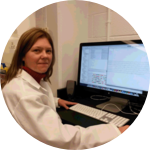About This Project
Moth and sand flies comprise a diverse lineage with approximately 3,020 described species. Adult females of many sandflies feed on the blood of vertebrates and transmit agents of various diseases. This project will use a massively large molecular dataset to reconstruct the tree of life for the moth and sand fly radiation. Our resulting tree will provide a framework for revising the taxonomy and nomenclature of the group and determine the origins of blood feeding in disease vector species.
Ask the Scientists
Join The DiscussionWhat is the context of this research?
Moth and sand flies (Insecta: Diptera: Psychodidae) is a diverse lineage of flies with extraordinary variation in their feeding behaviors. Some larvae are detritivores feeding on decaying plants, feces or dead snails while others feed on fungi, rotting wood or algae. Adult females of many species feed on the blood of vertebrates such as amphibians, reptiles, and mammals including humans.
Two recent investigations attempted to clarify evolutionary relationships in this group by analyzing molecular data; however, these results provided minimal resolution due to a limited sampling of genes. Our project will use hundreds of molecular markers to build the tree of life for these flies, providing a framework for the development of modern identification tools and estimating host associations.
What is the significance of this project?
Moth and sand fly species are common in urban and domestic habitats where they feed on organic buildup within drains, or septic tanks. Some are known to serve as vectors for agents of human diseases such as bartonellosis, sandfly fever, and most importantly, leishmaniasis. An estimated 310 million people are at risk for this disease, with 300,000 cases and more than 20,000 deaths annually .
Researchers are faced with many challenges involving the study of moth and sand flies: biodiversity inventories in periled habitats, investigations in the spread of sand fly-borne disease due to climate change, and vector species surveillance programs are dependent on understanding relationships within the family.
What are the goals of the project?
Recent studies have focused on adult host preferences of important vector species, yet little is known about the origins of adult feeding behaviors across the family and where host shifts may have occurred. Understanding feeding behaviors within an evolutionary framework has great predictive value for identifying groups most likely to serve as vectors of human disease agents. If funded, we will sample ~550 recently designed molecular markers to reconstruct the tree of life for these flies in order to 1) determine the origin(s) of blood feeding and 2) pinpoint where shifts from non-human to human hosts may have occurred and test 3) to what extent particular feeding guilds (e.g., amphibian vs. reptile feeding) are conserved among sister taxa. Our proposed start date is April, 2016.
Budget
We will sample 25 moth and sand fly species in order to reconstruct their phylogenetic relationships. We will use "next-gen" sequencing techniques to develop a modern framework for these species allowing us to This preliminary dataset will allow us to 1) determine the utility of our next-generation loci in resolving evolutionary relationships in this group 2) examine the origins of adult host associations 3) write grant proposals to other agencies.
Endorsed by
Meet the Team
Team Bio
Dr. Gregory R. Curler, Unaffiliated
Dr. Brian M. Wiegmann, North Carolina State University
Dr. Stephen D. Gaimari, California State Collection of Arthropods
Jennifer Zaspel
My lab investigates the evolutionary origins of insect groups in order to better understand their feeding behaviors, mating strategies and chemical communication. We use metabolomic, genomic, and transcriptomic approaches to reconstruct phylogenetic trees for species that feed on a broad range of hosts such as fungi, lichens, toxic plants, and vertebrates. My program also investigates the molecular and environmental mechanisms that influence host switching in insects that pierce mammalian skin to feed on blood. We conduct domestic and international fieldwork in order to collect samples for molecular, morphological and behavioral research. The specimen-based portion of my research program involves revisionary systematics, specimen informatics, and digitization. I am also the Director of the Purdue Entomological Research Collection, which houses over 2 million insect specimens. My program is highly involved in advanced digitization of these specimens, which will allow members of the scientific and public communities to explore PERC holdings and accelerate biodiversity research and discovery.
Lab Notes
Nothing posted yet.
Project Backers
- 6Backers
- 5%Funded
- $150Total Donations
- $25.00Average Donation

